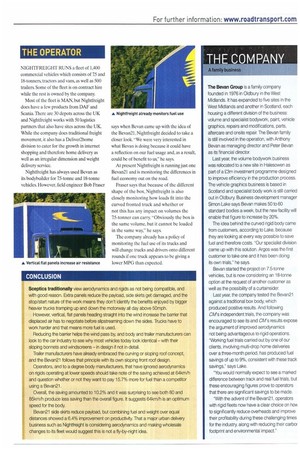CONCLUSION
Page 43

If you've noticed an error in this article please click here to report it so we can fix it.
Sceptics traditionally view aerodynamics and rigids as not being compatible, and with good reason, Extra panels reduce the payload, side skirts get damaged, and the stop/start nature of the work means they don't identify the benefits enjoyed by bigger heavier trucks tramping up and down the motorway all day above 50mph.
However, vertical, flat panels heading straight into the wind increase the barrier that displaced air has to negotiate before slipstreaming down the sides. Trucks have to work harder and that means more fuel is used.
Reducing the barrier helps the wind pass by, and body and trailer manufacturers can look to the car industry to see why most vehicles today look identical with their sloping bonnets and windscreens in design if not in detail.
Trailer manufacturers have already embraced the curving or sloping roof concept, and the Bevan21 follows that principle with its own sloping front roof design.
Operators, and to a degree body manufacturers, that have ignored aerodynamics on rigids operating at lower speeds should take note of the saving achieved at 64km/h and question whether or not they want to pay 15.7% more for fuel than a competitor using a Bevan21.
Overall, the saving amounted to 10.2% and it was surprising to see both 80 and 85km/h produce less saving than the overall figure. It suggests 64kM/h is an optimum speed for the body.
Bevan21 side skirts reduce payload, but combining fuel and weight over equal distances showed a 6.4% improvement on productivity That a major urban delivery business such as Nightfreight is considering aerodynamics and making wholesale changes to its fleet would suggest this is not a fly-by-night idea.
















































































































































